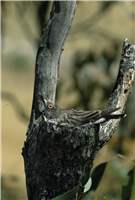Family
Neosittidae
Genus
Daphoenositta
Species
chrysoptera
Threats/Control Methods - Regional
Land clearing and urban development poses the biggest threat for this species. In the ACT, it is possible that as little as 3-4% of the original extent of the Yellow Box/Red Gum Grassy Woodland remains in something like its natural state. Worse still, the adjoining NSW woodlands only remain at 0.01% of their original extent. The invasion into suitable habitats by introduced weeds, grazing and predation by feral and uncontrolled domestic animals are also key threats.
Threats/Control Methods - Local
The limited number of mature trees in the suburbs and the threat of attacks from free roaming domestic pets make the suburban environment unfavourable.
Local/Urban Actions
Canberra residents can encourage the birds into the local region by participating in tree planting or bush regeneration activities with local Landcare groups or with Greening Australia. Pet owners can encourage Sittellas safely into the suburbs by providing a stimulating indoor environment for their animals or by installing a cat enclosure.
Common Names
Varied Sittella, Tree-runner, Bark-pecker, Diamond or Little Woodpecker, Nuthatch
Distinguishing Features
The Varied Sittella is a small, stocky bird, 11-13cm in size. It has bright yellow legs and feet, a yellow beak and a yellow ring around the eye. The plumage is a grey brown colour with creamy streaks throughout. The forehead and tail are darkest in colour, while the underbelly is light. The wings have a thick orange band through the middle that is obvious in flight.
Survey Techniques
Call and visual identification.
Species Call
A rapid call and answer medley of high-pitched, loud, metallic 'chwit'.
Similar Species
Treecreepers also have orange in the wings and forage on tree bark, however the distinctive size, shape, calls and tree diving behaviour is unique to this species.
Distribution
This species is found widely throughout NSW and VIC.
Country of Origin
Australia
Conservation (Pet/Pest) Status - Regional
Species numbers are declining overall (COG).
Conservation (Pet/Pest) Status - National
This species is considered Vulnerable in the EPBC Act 1999.
LSCCES Population
A small number were seen at BMP and one was spotted at ANU.
Associated vegetation community
Varied Sitellas are found in eucalypt woodland and forest. They prefer rough-barked trees like stringybarks and ironbarks or mature trees with hollows or dead branches.
Limiting Resources
These birds require very dense stands of eucalypt trees across a fairly big area, including thick shrub layers and ground vegetation.
Breeding
Nest building begins around October in the Canberra region and dependant young are seen from December to February. The nest is a deep open cone of bark and spider web, camoflaged to look like a branch. This species usually breeds cooperatively, with the breeding pair having several helpers. However, only the breeding female incubates in the nest for over 2 weeks. The three eggs are light blue with dark blue spots. The group all help with feeding the young for about 18 days.
Behaviour
The Varied Sittella can be seen foraging in the rough branches, spiralling headfirst downwards around the tree trunk or branches.
Functional Group
Food Species
The birds work their way down trees for any insects taking refuge under the bark, including spiders, ants and moths.
Predators
Both domestic and feral Cats (Felis catus) in the region may prey upon Sittellas, however their disguised nest gives them a slight advantage over some other birds.
Interesting Fact
The nest of this species is so well camouflaged that when a bird stops to feed its young, it looks like it is simply pecking the tree for food.
References - (reader suitability of references, P=Primary teachers, S=Secondary students, T=Tertiary students and researchers)
Books:Freudenberger, D. 2001. Bush for the birds: Biodiversity enhancement guidelines for the Saltshaker Project, Boorowa, NSW. Consultancy report to Greening Australia ACT and SE NSW Inc. CSIRO Sustainable Ecosystems. Canberra. S, T
Morcombe, M. 2000. Field Guide to Australian Birds. Steve Parish Publishing. Archerfield. Australia P, S, T
Pizzey, G. 2000. The Graham Pizzey & Frank Knight Field Guide to the Birds of Australia. Angus & Robertson, Sydney. P, S, T
Veerman, P. 2003. Canberra Birds: A report on the first 21 years of the garden bird survey. Philip Veerman and Canberra Ornithologists Group. Canberra. S, T
Internet: Birds in Backyards. 2006. [online]. Available at:http://www.birdsinbackyards.net P, S, T
Canberra Ornithological Group (COG). 2004. Birds of Canberra Gardens. COG and the ACT Department of Urban Services. [online]. Available at:http://garden.canberrabirds.org.au/ P, S, T
Online Publications:ACT Government. 2004. Woodlands for Wildlife: ACT Lowland Woodland Conservation Strategy. Action Plan No. 27. Environment ACT, Canberra. [online]. Available at: http://www.environment.act.gov.au/nativeplantsandanimals/threatecspec/woodlandsstrategy S, T
Environment ACT. ACT Government. 2006. Action Plan No. 18: Brown Treecreeper. [online]. Available at:http://www.environment.act.gov.au/__data/assets/pdf_file/13567/actionplans18.pdf S, T
Nix, H. and Cunningham, R. 2006. Birds of the Lower Sullivans Creek Catchment, Canberra ACT. Prepared for the Life in the Suburbs project using data from the Lower Sullivans Creek Catchment Ecological Survey (LSCCES). Australian National University. Canberra. [online]. Available at: http://www.lifeinthesuburbs.com.au/category.php?id=65 S, T

 Top
Top Top
Top